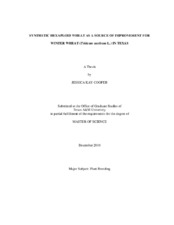| dc.description.abstract | Synthetic hexaploid wheats, created from a durum (Triticum durum) cross to Aegilops tauschii Coss. (McFadden and Sears, 1946), proved to be an efficient and beneficial source of new genes for common bread wheat (Triticum aestivum L).
The purpose of this research was to evaluate the potential and performance of synthetic wheat in Texas. Ten elite primary synthetics from the International Maize and Wheat Improvement Center (CIMMYT), screened for desirable traits, were backcrossed to two Texas cultivars, TAM 111 and TAM 112. Populations were bulked and modified bulked to advance generations. Agronomic traits related to yield were determined on the F4 and F5
Improvement was observed in South Texas and the Blacklands, which have more disease pressure and fewer intermittent dry spells than another two locations at Chillicothe and Bushland in Texas Rolling and High Plains, respectively. Selected bulks were not superior to non-selected bulks. Head number per unit area had the highest correlation with yield and seed weight was the most heritable trait. Synthetic lines combined better with TAM 111 than TAM 112 in high yielding environments. populations across five Texas locations. Similar to crosses with spring wheat, synthetics contributed to yield through an increase in seed weight. Synthetic populations that produced higher grain yield than both TAM 111 and TAM 112 were able to maintain their large seed size and weight while improving their seed per head and head number traits. Poorer performance in environments with harsh winters could be due to a lack of winter-hardiness in the primary synthetics. This clearly demonstrates that improving yield, through utilization of common wheat by synthetic crosses, could result from selecting for larger seed per head and heads per unit area in lines driven from these populations.
Introgression of new genes through synthetic backcrosses could contribute to the improvement of wheat in particular regions of Texas. Primary synthetics and recurrent parents combining for superior hybrids were identified. | en |


